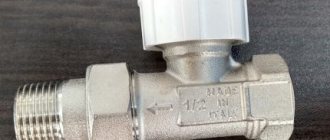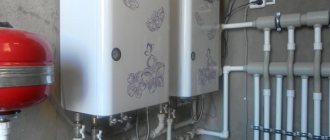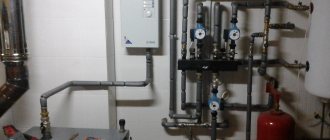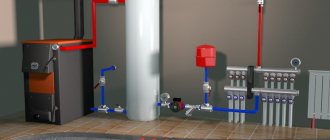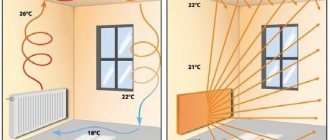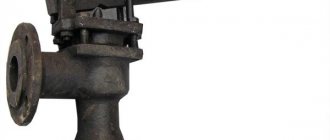Overheating of the coolant leads to its strong expansion, especially if the temperature has reached the boiling point. When the coolant expands, the pressure in the system rises, which can lead to serious consequences: from slight leakage of connections or failure of heating system components, to rupture of lines in inaccessible places (walls or under floor screed).
A well-known way to prevent the destruction of a heating system due to high pressure is a safety relief valve. In the article we will look in detail at its design and operating principle, define the criteria for choosing a mechanism, the installation algorithm in the heating system, as well as actions in a situation if the pressure relief valve has leaked.
Purpose of a safety valve in a heating system
Adjustable spring safety valve.
Most often used in individual heating systems. An increase in the temperature of the coolant in the heating water circuit leads to an increase in the pressure exerted on the walls of the system. Particularly critical are temperatures above 90-95°C, when water begins to boil, releasing steam. The pressure in the system increases exponentially. If modern pipes and radiators are designed, as a rule, for a pressure of 6-9 bar or more, then the most vulnerable point of the system is the boiler heat exchangers, which in modern models can withstand pressures of up to 3 bar, and in older models even 2 bar.
Subsequently, not just a heat exchanger leak may occur, but also a short circuit or a serious flood due to leakage of large volumes of coolant.
The safety valve ensures the automatic release of steam or coolant, freeing up space in the system for expansion due to heating, which prevents the pressure inside the water circuit from reaching critical values. After the pressure is released, the valve also closes automatically. The valve is inserted into the pipeline near the boiler itself, often a pressure gauge and an automatic air vent are also installed with it; together this complex is called a safety group.
The principle of preventing critical pressure levels in the heating system using a safety valve.
If modern models of gas and electric boilers, thanks to advanced automation, are able to prevent overheating, at least by simply turning off the burners in a timely manner, then for solid fuel boilers the installation of a safety valve is mandatory. Even after closing the damper, the heat exchanger in the solid fuel boiler continues to receive heat for some time. It is precisely because of the inertia of the heat generator that serious overheating can occur.
A relief valve is also mandatory for steam boilers (usually used for industrial purposes). However, we recommend installing a safety valve into the heating system with any boiler, including gas, installing the valve as part of the safety group.
Please note that for large volumes of the heating system (for example, designed to heat a house over 500-600 m2), it is recommended to install 2 safety valves on each boiler - a working one and a control one.
Why do you need a safety valve for a heating boiler?
In any heating system, an emergency situation may occur due to increased heating of the coolant, during which it expands and disables the boiler. To prevent an accident leading to significant financial losses, a safety valve is used in the heating system, installed in close proximity to the boiler.
The relief valve is used in all communal and individual heating systems of private houses, where it is the main element of protecting boiler equipment and increasing the safety of its maintenance. To install it correctly, you must accurately select the device according to the technical characteristics of the system and know the technologically correct installation location.
Drain valve in the heating boiler piping
Purpose of the safety valve
Unlike heating systems with an open expansion tank, where pressure changes lead to an increase in the volume of coolant in the tank or, in emergency situations, evaporation of water into the environment, in a closed loop all processes occur inside the boiler and pipeline. To remove excess expanded working fluid from a closed system, automatic valves are used that are adjusted to its physical parameters, more precisely, pressure.
During operation, the coolant has the highest pressure and temperature at the boiler outlet; moreover, the heating equipment is the most expensive in the system - because of these factors, the safety valve of the heating system is installed next to the boiler and is designed to protect it.
How does a safety valve work?
The valve that protects the boiler has a simple device and operates on a principle that is understandable even to a schoolchild. The device consists of a straight fitting with a 90-degree outlet and a spring-loaded seal that closes the side passage. When the pressure in the system increases due to overheating, exceeding the pressing force of the spring holding the valve in a stationary position, it rises up and opens the side hole.
Excess liquid begins to pour out from the side and is sent to a container, drainage or sewer system. After bleeding part of the coolant, the pressure in the system and on the valve weakens, the spring puts it in place, closing the side pipe.
Spring-type structural device
A typical safety valve for a boiler has a collapsible design and consists of the following main elements:
Frame . Usually made of brass and shaped like a tee. On its sides there is a lower inlet threaded hole, a side outlet pipe and an upper seat on which the shaped seal is seated.
Locking group . It is a spring-loaded pulley with a cylindrical (disc) end locking element, onto which an elastic rubber seal in the form of a cup (disc) is placed.
Lid . A black cap made of heat-resistant polymer is screwed into the upper threaded pipe of the brass body, holding the spring-loaded rod in the working position. On the upper edges of the lid there are protrusions along which the upper cap, shaped at the bottom, slides, connected to the locking rod. When turned to a certain angle, the cap rises along with the rod and opens the side pipe - this allows you to use the safety valve for heating always open in manual mode.
Cap. The polymer part is usually red in color with a ribbed side surface, and is screwed to the hollow inside of the rod with a screw. The gentle protrusions at the bottom of the cap, when rotated, fall on the teeth of the lid - the handle rises along with the spring-loaded shutter and opens the side channel, allowing you to relieve pressure manually.
Adjusting washer . The inner wall of the cover has a thread in which the adjustment nut rotates; when lowered down, it compresses the spring - thus increasing the valve response threshold. When the nut is unscrewed upward, the spring weakens and the actuation pressure decreases. For turning, the nut is equipped with a transverse slot in the upper part for a flat-head screwdriver.
Valve for water heating boilers - design and appearance
Varieties
Existing types of valves are capable of working with boiler equipment from leading foreign (Vaillant, Baxi, Ariston, Navien, Viessmann) and domestic (Nevalux) manufacturers using gas, liquid and solid fuels in situations where automatic control of the system operation due to the type of fuel is difficult or broken when the automation fails. Depending on their design and operating principle, safety valves are divided into the following groups:
- According to the purpose of the equipment in which they are installed:
- For heating boilers that have the above design, they are often supplied on fittings in the form of a tee, into which a pressure gauge is additionally installed to check the pressure and a venting valve.
- For hot water boilers, the design includes a flag for draining water.
- Tanks and pressure vessels.
- Pressure pipelines.
- According to the operating principle of the clamping mechanism:
- From a spring, the clamping force of which is regulated by an external or internal nut (its operation is discussed above).
- Lever-load type, used in industrial heating systems designed to discharge large volumes of water; their response threshold can be adjusted by hanging weights. They are suspended on a handle connected to the shut-off valve using a lever principle.
Lever-load modification device
- Locking mechanism speeds:
- Proportional (low-lift spring) - the sealed lock rises in proportion to the pressure and is linearly related to its increase, while the drain hole gradually opens and closes in the same way with a decrease in the volume of coolant. The advantage of the design is the absence of water hammer under various modes of movement of the shut-off valve.
- Two-position (full-lift lever-load) - operate in open-closed positions. When the pressure exceeds the response threshold, the outlet hole opens completely and the excess coolant volume is released. After the pressure in the system is normalized, the outlet is completely blocked; the main drawback of the design is the presence of water hammer.
- Non-adjustable (with caps of different colors).
- Adjustable screw parts.
- According to the design of the spring compression adjusting elements:
- An internal washer, the operating principle of which was discussed above.
- External screw, nut, models are used in domestic and communal heating systems with large volumes of coolant.
- Using a handle, a similar adjustment system is used in flanged industrial valves; when the handle is fully raised, it is possible to perform a one-time release of water.
Designs of various models of drain valves
How to choose a valve for a heating boiler
When choosing a safety valve for heating, we are guided by the following considerations:
- The determining factor for selecting a safety valve is its response pressure. The usual standard for household appliances used in the heating system, according to calculations, is 3 bar. This indicator is due to the fact that in most individual closed circuits with radiators using circulation pumps, coolant is transported with a standard pressure of 1.5 bar. Its fluctuations when heated to the highest temperatures can reach 2.5 bar, and a limit value of more than 3 bar indicates overheating of the coolant and can become critical for polymer pipelines (the boiler can withstand significantly higher hydraulic loads).
- Among the models on the market, there are a lot of products from China from little-known brands. The Russian-Italian product Valtex, valves from the Italian boiler manufacturer Baxi, have a good price-quality ratio. Many well-known suppliers of electric boilers with the brands Vailant, Ariston, Baksi additionally produce related equipment, which includes safety valves.
- From the point of view of cost, ease of installation and functionality, it is best to purchase a security group. The unit additionally includes a pressure gauge (allows you to control the setup process and pressure in the system) and an automatic valve for bleeding air in the circuit.
Design and principle of operation depending on the type
Lever-load
Lever safety valves are used exclusively in industrial systems and are designed for heavy loads and pipeline diameters over 200 mm.
A weight hung on the lever exerts pressure on the rod. When the force exerted by the pressure in the system on one side exceeds the force exerted by the load on the other side, the rod opens, releasing coolant or steam. As soon as the pressure force inside the system becomes insufficient (it does not reach a critical point), the rod, under the weight of the load on the lever, blocks the system.
Sectional view of a lever-weight relief valve.
Thus, the critical pressure at which it is necessary to release is regulated by the length of the lever and the weight on it.
Spring
A more modern and cheaper option is the spring safety valve. It is not inferior in efficiency to a lever-load type, is reliable and has compact dimensions, therefore it is widely used in individual heating systems of private houses.
A spring relief valve works on the same principle, only instead of a load, a spring acts on the rod:
- from the inside, a flow of water or steam exerts pressure on the valve of the device;
- on the other side there is a spool pressed by a rod, which is acted upon by a spring;
- the pressure in the system exceeds the clamping force of the spring, the spool rod rises up, and depressurization occurs;
- coolant or steam exits through the outlet pipe;
- the pressure inside the system decreases and becomes lower than the pressing force of the spring, which closes the shutter again, returning the mechanism to its original position.
The operating principle of a spring safety valve designed for an individual heating system.
There are both valves designed for a specific pressure (for example, 3, 6 or 8 bar) and adjustable valves, the critical pressure for relief is set during installation. They can also be open or closed. The first ones discharge water or steam into the external environment, closed valves - into the pipeline connected to them.
Thermal relief valves
Spring-loaded safety valves are also imperfect. In addition to the fact that they work exclusively in closed systems (since boiling of the coolant in a system with an open expansion tank can occur without increasing pressure), spring mechanisms are triggered when the temperature of the coolant has already exceeded a significant level - over 95-100 ° C.
The most effective, but extremely expensive, is the thermal relief valve, which responds to an increase in the temperature of the coolant, and not the pressure in the system. The principle of operation is the same membrane, which is controlled by a spring, but it is driven not by the pressure of the water flow, but by a heat-sensitive liquid that expands significantly when heated by the coolant.
Operating principle and setting of a lever-weight safety valve
The lever is the main element of these valves, on which a load (weight) is hung and secured with a locking screw. The opening of the device depends on the position of the weighting agent: the farther the weight is located on the lever and the greater its weight, the greater the pressure required to operate the device. So, in safety lever-weight valves, the weighting force coming from the lever to the rod counteracts the pressure of the working medium, which creates a force on the spool.
- The valve is adjusted in two ways:
- quantitative regulation. The mass of the weighting material ensures that the rod is pressed against the spool; the required amount of weights is determined based on the pressure level at a certain value of which the valve operates.
- moving weights along the lever. The further away the lever weight is from the valve body, the greater the pressure required to operate the safety equipment. Using this method, more precise valve adjustment is made.
Upon completion of the adjustment and fixation of the weighting material, a protective casing is put on the device and sealed to prevent unauthorized reconfiguration.
Return to list
Safety relief valve selection criteria
Clamping mechanism
Lever-load safety valves are designed for heavy loads and a pipe diameter of at least 200 mm, therefore they are used in industrial heating systems.
For individual heating of a private house, it is better to purchase a device with a spring mechanism; this is a standard, reliable and frequently used type of relief valve.
If you are on a budget, we recommend purchasing a more efficient thermal relief valve, which will prevent the problem before the pressure in the heating system seriously increases.
Lifting height
Pressure relief valves have different valve lift heights:
Low-lift model PS-350.
Low-lift . The height of the shutter in low-lift valves does not exceed 1/20 of the seat diameter. They have a relatively low throughput and a simple design. Used in lines with liquid coolant. As a rule, low-lift safety valves are sufficient for a heating system with a water circuit with a power of up to 40-43 kW. To prevent an accident in such systems, it is necessary to discharge a small volume of coolant.- Full lift . The height of the valve in full-lift valves is greater than or equal to the diameter of the seat. As a rule, these are lever-load mechanisms, more expensive and complex in design. Full-lift valves have a high capacity and can be installed on lines in which gases, steam or compressed air circulate.
Full lift model PN 16.
Mechanism response speed
Based on response speed, safety valves are divided into proportional and on-off.
In heating systems of a private home, it is better to use proportional valves; again, they are sufficient for most systems. The shutter cover of such devices opens gradually, in proportion to the increase in pressure in the line, and accordingly, the volume of coolant discharged increases proportionally. Such valves do not self-oscillate, they maintain the correct pressure level and are cheaper.
Two-position safety valves are distinguished by instantaneous detonation and full opening of the valve. This mechanism allows you to quickly release large volumes of coolant, but creates the risk of water hammer: due to the rapid release of a large amount of coolant liquid, the pressure in the line significantly decreases, after which the valve closes sharply. Therefore, it is recommended to install two-position safety valves on lines with a compressible medium (air, gas, steam).
Diameter
The diameter of the pressure relief valve in the heating system should not be less than the connector of the supply pipe. Otherwise, the constant hydraulic pressure will interfere with the operation of the mechanism.
Manufacturer
Since safety valves have a fairly simple design, and modern models are in most cases made of brass using the same technology, there are no critical differences between valves from different manufacturers.
The difference between some is higher quality processing, inspection and testing of devices and a guarantee of a long service life without leaks - from 15 years. There are manufacturers whose safety valves we can recommend above all: VALTEC , WATTS , Protherm .
Installing the device into the system
Schematic illustration of a boiler piping using a pressure relief valve.
Some boilers, usually wall-mounted, already have emergency valves installed by the manufacturer. If it is not there, a safety valve is installed on the boiler supply line in compliance with all the requirements described below:
- location on the supply pipeline – 200-300 mm from the boiler;
- in systems with natural circulation, emergency valves are installed at the highest point;
- For tightness, it is important to seal the threads of the fittings with tow or silicone (but not with FUM tape, which cannot withstand temperatures above 70-80 degrees without deformation);
- the valve itself must be positioned vertically (with the plastic handle up) so that an air gap is maintained under the spool; with this installation, the mechanism has the longest service life;
- It is advisable to install a pressure gauge in front of the valve (if it is not part of the safety group);
- there should be no check valves, gate valves or taps on the line between the boiler heat exchanger and the discharge valves;
- To prevent the coolant from dripping onto the floor when the valve ruptures, it is necessary to put a drain pipe leading to the sewer or return line onto the valve;
- when venting to the sewer, it is important to make a connection that involves breaking the stream (for example, through a funnel and a water seal). Thus, the system will work even if the drainage pipeline is clogged and will rid the boiler room of coolant odors.
We also recommend installing shut-off valves after the blast valve. The thing is that after 5-8 operations, the valve spring often does not work correctly and the mechanism requires replacement (fortunately, the cost of the fittings is low). However, the valve can be removed and replaced only by draining the coolant and reducing the pressure in the system to atmospheric pressure. The above-mentioned shut-off valves will help you get by with draining the coolant only from the boiler, and not from the entire system.
How to choose a water softener for a gas boiler and extend its service life
Adjusting the mechanism for proper operation
The safety valve is adjusted after completion of installation work and complete flushing of the system. Spring devices can be adjusted by rotating the adjusting knob (colored plastic cap), the rotation compresses or decompresses the spring that puts pressure on the spool. In lever-load trucks, this is done by hanging a load on the lever.
It is necessary to set the set pressure, full opening and closing:
- The setting pressure should be set slightly higher than the maximum operating pressure of the boiler.
- The full opening pressure should not exceed the maximum permissible standards of the most vulnerable element of the system, usually the boiler heat exchanger, designed for 3 or 2 bar, and in some Russian models even 1.5 bar.
- The valve closing pressure must be set slightly higher than the minimum allowable for system operation.
It is recommended to check the serviceability of emergency valves at least once every 6 months.
Setting up safety valves
The protective devices are configured after installation and flushing of the system.
Checking safety valves takes place in several stages:
- A pressure setting that is set slightly above the maximum operating pressure.
- Check the pressure when opening, it should not exceed the minimum. Corresponds to normal operation. The pressure in the spring safety valve can be adjusted by rotating the adjusting screw, which compresses the spring. The lever is adjusted by changing the weight of the load.
- Checking for complete opening and closing.
The adjustment need not be made for safety devices in which the pressure is fixed by the manufacturer. A safety valve can be considered ready for operation if air and water tightness is ensured, the valve opens and closes well, the opening and closing pressures have deviations within the permissible limits for this type (see device passport).
The frequency of checking safety valves is once a quarter.
After all the adjustment manipulations, it is necessary to seal, assign a number and apply it to the body of the protective device (or on a plate, it is welded to the valve body; it indicates: installation location, pressure), draw up an operational card or technological passport.
What to do if water drips through the relief valve
The nature of the problem depends on whether the water from the safety valve is dripping or flowing in a stream.
If the coolant is dripping, this indicates normal operation of the emergency valves, but the heating system is operating at the limit, since the temperature in the coolant in it is increased and the pressure exceeds the norm. It’s easy to check whether the drops are the natural operation of the mechanism - just lower the operating temperature, allowing the coolant to cool. If the water drainage stops, then everything is in order, you just need to prevent further reheating.
A mechanism clogged due to contaminated coolant. Particles of sand and dirt prevent the rod from completely closing, which causes leakage.
If the drops do not stop or the coolant is discharged in large quantities, in a stream, this indicates a malfunction of the safety valve: the spring, rubber or silicone seal are worn out, the fitting is clogged, as a result of which it does not fit tightly. It is not recommended to disassemble the mechanism yourself; in this case, it is necessary to replace the relief valve (issue price 400-900 rubles).
Price
The price of the mechanism depends on its type, characteristics, materials and workmanship, quality of processing and manufacturer's markup.
| Model | Allowable pressure, bar | Cost, rub. |
| Spring | ||
| WATTS SVH 3/4″x1″ | 3 | 690 |
| VALTEC ½ (VT.0490.IG.0460) | 3 | 550 |
| VALTEC ½ (VT.1831.N) – adjustable | 12 | 915 |
| Lever-load | ||
| Pregran KPP096-01 Du15 | 16 | 19 200 |
| 17s28nzh Du50 Ru10-16 | 16 | 12 000 |
| Thermal relief valves | ||
| Watts STS 20 art. 02.32.120 | — | 4 900 |
| Protherm Caleffi 544 – 1/2″ | — | 12 000 |
InstructionsBoiler room equipmentSafety fittings
